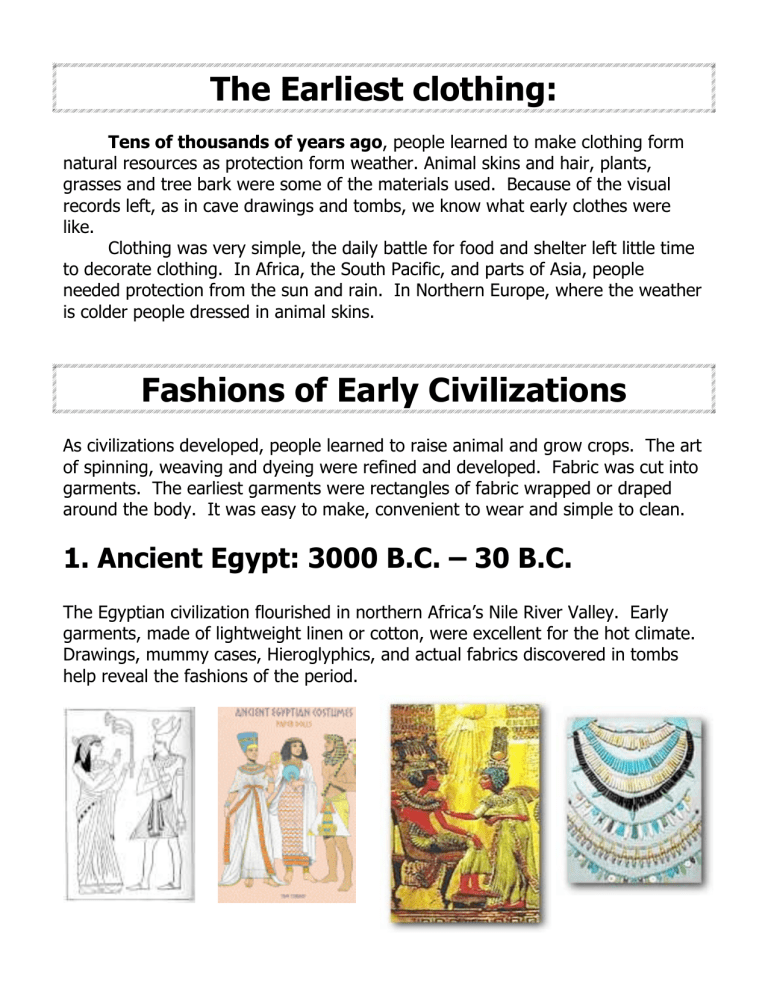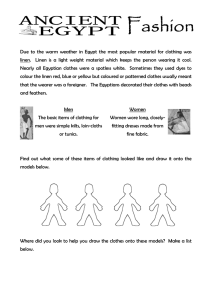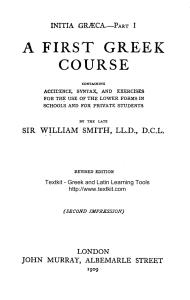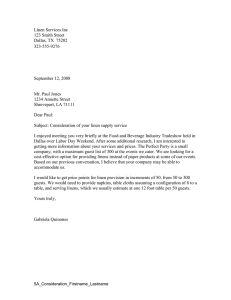Uploaded by
Christine Lafitte
Ancient Civilizations Clothing History: Egypt, Greece, Rome
advertisement

The Earliest clothing: Tens of thousands of years ago, people learned to make clothing form natural resources as protection form weather. Animal skins and hair, plants, grasses and tree bark were some of the materials used. Because of the visual records left, as in cave drawings and tombs, we know what early clothes were like. Clothing was very simple, the daily battle for food and shelter left little time to decorate clothing. In Africa, the South Pacific, and parts of Asia, people needed protection from the sun and rain. In Northern Europe, where the weather is colder people dressed in animal skins. Fashions of Early Civilizations As civilizations developed, people learned to raise animal and grow crops. The art of spinning, weaving and dyeing were refined and developed. Fabric was cut into garments. The earliest garments were rectangles of fabric wrapped or draped around the body. It was easy to make, convenient to wear and simple to clean. 1. Ancient Egypt: 3000 B.C. – 30 B.C. The Egyptian civilization flourished in northern Africa’s Nile River Valley. Early garments, made of lightweight linen or cotton, were excellent for the hot climate. Drawings, mummy cases, Hieroglyphics, and actual fabrics discovered in tombs help reveal the fashions of the period. Men usually dressed in short linen kilts with a band of cloth worn over the shoulders, and women in long fitted linen dresses. During the New Kingdom, fashion became more complex, with intricate pleats introduced to tunics and dresses. Ordinary Egyptians wore course linen, whilst the richer and wealthier Egyptians dressed in a lighter, much finer cloth. Semi-transparent “royal linen” was the finest of all. Skins, usually leopard skin would sometimes be worn by priests and the pharaoh for important temple and religious rituals. Elaborate clothing and head-dresses were worn by royalty for ceremonial occasions Textile manufacture and dressmaking were the only areas of the economy that remained predominantly in female hands. For a long time it was mainly the women who were working in the spinning and weaving workshops. Many of these workshops were incorporated within the more wealthy and aristocratic houses of the nobility. The basic garments of the average Egyptian changed little throughout Egypt's history. The length of a man's kilt varied slightly, being initially short during the Old Kingdom, although within the upper classes it became fashionable to wear it longer. The kilt gradually lengthened during the Middle Kingdom, when it was often supplemented with a strip of linen draped loosely over the shoulder which evolved into short sleeves, and later into long sleeves. The cloth, which was sometimes pleated, was wrapped round the waist and held in place by a belt. Very little stitching was used. A woman's tunic was made from a long rectangular piece of cloth with an opening cut in the centre to fit over the head. The fabric was folded in half, and the lower sides were sewn together, leaving openings for the arms. The tunic could cover one or both shoulders, or be worn with shoulder straps. The top of the tunic could reach anywhere from the neck to below the breast, and was usually ankle length. The fit might be very tight or quite loose. A tied belt held the cloth together. http://www.egyptologyonline.com/dress.htm 2. Ancient Greece: 3000 B.C. – 100 B.C. The Greeks fashioned their garments by elaborate wrappings, draping, and pinning long rectangular pieces of fabric, which were dozens of square feet in width and length. Greek clothing was made out of three types of materials. The first mostly used was wool which was woven from very coarse to very soft. They used linen grades from fine to very soft. Drapery in Greek culture did not fold crisply like Egyptian folds fell and the linen was not as stiff as the linen used in Egypt. Greek garments were essentially the same for men and women and were not shaped or fitted to the body but draped on the body in soft folds. There were four types, which were all rectangles: the chiton (dress), Doric and Ionic over draperies, the himation and the chlamys. Men wore their hair long at the beginning of Greek culture but it soon became fashionable to have shorter hair with little facial hair. Older men would wear mustaches with a shortly-trimmed beard and if a man had a mustache and no beard they were not Greek. In the archaic period women wore their hair hanging in snaky curls held by a fillet but as time passed women would wear their hair up and confined in bag, kerchiefs or nets. Colors of this period were bright-hued like yellow, indigo, green, violet, dark red, dark purple and colors that were from the earth. Motifs ranged from geometric like the dentil and arrangements of circles and squares to vegetable forms like the laurel, ivy and waterleaf. http://www.cwu.edu/~robinsos/ppages/resources/Costume_History/greek.htm 2. Ancient Rome: 753 B.C. – 476 A.D. As Roman rule spread from present day Italy onto Greece, many elements of Greek culture, including clothing were adopted. The Greek himation became the basis for the Roman toga. Roman ingenuity of solving problems of all sorts was not only to apply itself to engineering and architecture, but also to the mundane matter of clothing. First and foremost clothes needed to be simple. As for possible materials there was only really one. Wool, although to some extent linen was also available. The very early Romans wore a toga. It looked like a white sheet 9 yards long. Togas were arranged very carefully, in a stylish way. The toga always exposed the right arm and usually covered the left one. Different colours identified various occupations and class ranks. Only the emperor could wear a purple one. In the early days the toga was worn directly on the naked body, then later a simple tunic was added, tied at the waist with a belt. Togas fell out of style rather early. (The toga was inconvenient, and people felt the cold when they wore it.) To get anyone to wear them, even very early emperors had to legislate the wearing of togas by at least senators. Eventually, the emperors gave up. The Romans switched to comfortable tunics, which looked like long tee-shirts. They were far more practical. Tunics were made of cool linen, for summer wear, and warm wool, for winter wear. Sometimes, they wore trouser like affairs. As undergarments Romans would wear a simply loin cloth knotted on each side. Women would also wear a simple brassière in the form of a band, tightly tied around her body. http://www.roman-empire.net/society/soc-dress.html http://members.aol.com/Donnclass/Romelife.html#HAIR




